Polyethylene Glycol Functionalized Graphene Oxide Nanoparticles Loaded with Nigella sativa Extract: A Smart Antibacterial Therapeutic Drug Delivery System
- PMID: 34063773
- PMCID: PMC8196615
- DOI: 10.3390/molecules26113067
Polyethylene Glycol Functionalized Graphene Oxide Nanoparticles Loaded with Nigella sativa Extract: A Smart Antibacterial Therapeutic Drug Delivery System
Abstract
Flaky graphene oxide (GO) nanoparticles (NPs) were synthesized using Hummer's method and then capped with polyethylene glycol (PEG) by an esterification reaction, then loaded with Nigella sativa (N. sativa) seed extract. Aiming to investigate their potential use as a smart drug delivery system against Staphylococcus aureus and Escherichia coli, the spectral and structural characteristics of GO-PEG NPs were comprehensively analyzed by XRD, AFM, TEM, FTIR, and UV- Vis. XRD patterns revealed that GO-PEG had different crystalline structures and defects, as well as a higher interlayer spacing. AFM results showed GONPs with the main grain size of 24.41 nm, while GONPs-PEG revealed graphene oxide aggregation with the main grain size of 287.04 nm after loading N. sativa seed extract, which was verified by TEM examination. A strong OH bond appeared in FTIR spectra. Furthermore, UV- Vis absorbance peaks at (275, 284, 324, and 327) nm seemed to be correlated with GONPs, GO-PEG, N. sativa seed extract, and GO -PEG- N. sativa extract. The drug delivery system was observed to destroy the bacteria by permeating the bacterial nucleic acid and cytoplasmic membrane, resulting in the loss of cell wall integrity, nucleic acid damage, and increased cell-wall permeability.
Keywords: Nigella sativa; antibacterial activity; graphene oxide nanoparticles; polyethylene glycol; smart drug delivery system.
Conflict of interest statement
The authors declare no conflict of interest.
Figures






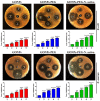
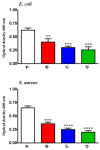
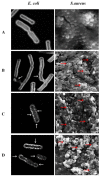
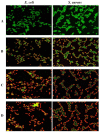
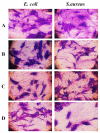
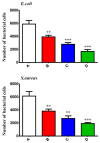
Similar articles
-
Antibacterial, antibiofilm and cytotoxic effects of Nigella sativa essential oil coated gold nanoparticles.Microb Pathog. 2016 Feb;91:129-35. doi: 10.1016/j.micpath.2015.11.021. Epub 2015 Dec 15. Microb Pathog. 2016. PMID: 26703114
-
Green synthesis of polyethylene glycol coated, ciprofloxacin loaded CuO nanoparticles and its antibacterial activity against Staphylococcus aureus.Sci Rep. 2024 Sep 11;14(1):21246. doi: 10.1038/s41598-024-72322-1. Sci Rep. 2024. PMID: 39261712 Free PMC article.
-
Nigella sativa seed extract applicability in preparations against methicillin-resistant Staphylococcus aureus and effects on human dermal fibroblasts viability.J Ethnopharmacol. 2019 Nov 15;244:112135. doi: 10.1016/j.jep.2019.112135. Epub 2019 Aug 1. J Ethnopharmacol. 2019. PMID: 31377263
-
Poly(Ethylene Glycol) Functionalized Graphene Oxide in Tissue Engineering: A Review on Recent Advances.Int J Nanomedicine. 2020 Aug 12;15:5991-6006. doi: 10.2147/IJN.S249717. eCollection 2020. Int J Nanomedicine. 2020. PMID: 33192060 Free PMC article. Review.
-
Poly(ethylene glycol)-Engrafted Graphene Oxide for Gene Delivery and Nucleic Acid Amplification.Materials (Basel). 2023 Nov 29;16(23):7434. doi: 10.3390/ma16237434. Materials (Basel). 2023. PMID: 38068178 Free PMC article. Review.
Cited by
-
Graphene Oxide Nanostructures as Nanoplatforms for Delivering Natural Therapeutic Agents: Applications in Cancer Treatment, Bacterial Infections, and Bone Regeneration Medicine.Nanomaterials (Basel). 2023 Sep 28;13(19):2666. doi: 10.3390/nano13192666. Nanomaterials (Basel). 2023. PMID: 37836307 Free PMC article. Review.
-
In vitro study of antioxidant, antibacterial, and cytotoxicity properties of Cordia myxa fruit extract.Iran J Microbiol. 2022 Feb;14(1):97-103. doi: 10.18502/ijm.v14i1.8810. Iran J Microbiol. 2022. PMID: 35664718 Free PMC article.
-
Evaluation of Antimicrobial Activity and Cytotoxicity of an Epoxy Resin-Based Endodontic Sealer Containing Nanoparticles Amorphous Calcium Phosphate.Int J Dent. 2023 Dec 5;2023:8717655. doi: 10.1155/2023/8717655. eCollection 2023. Int J Dent. 2023. PMID: 38090531 Free PMC article.
-
Liposome Nanocarriers Based on γ Oryzanol: Preparation, Characterization, and In Vivo Assessment of Toxicity and Antioxidant Activity.ACS Omega. 2024 Jan 11;9(3):3554-3564. doi: 10.1021/acsomega.3c07339. eCollection 2024 Jan 23. ACS Omega. 2024. PMID: 38284009 Free PMC article.
-
Electrochemical study of an enhanced platform by electrochemical synthesis of three-dimensional polyaniline nanofibers/reduced graphene oxide thin films for diverse applications.Sci Rep. 2024 Nov 2;14(1):26408. doi: 10.1038/s41598-024-77252-6. Sci Rep. 2024. PMID: 39488583 Free PMC article.
References
MeSH terms
Substances
LinkOut - more resources
Full Text Sources
Medical
Miscellaneous

